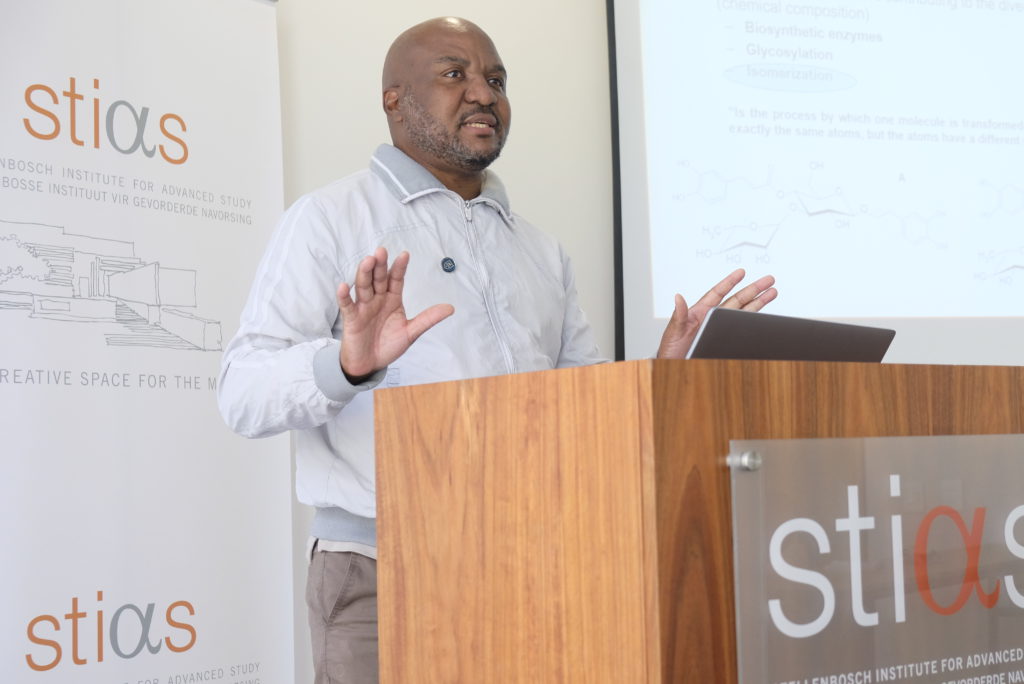“Due to depletion of the atmospheric ozone layer, there is excessive sunlight reaching the earth’s surface. Ultra-violet (UV) light associated with excessive sunlight is known to result in photo-oxidative damage in plants. However, plants have developed sophisticated chemical defence strategies to mitigate the negative effects associated with UV light exposure,” said Edwin Madala of the Department of Biochemistry at the University of Venda. Madala is a STIAS Iso Lomso fellow, currently in his second residence. In 2019 he was recognised as the Best Early Career/Emerging Researcher by the National Research Foundation, in 2020 he was appointed Associate Professor at the University of Venda, and he has trained and co-supervised 16 MSc and 3 PhD students. He presented a STIAS seminar updating the work of his group looking at the strategies that plants undertake to protect themselves against photo-induced stress caused by climate change and the impact of these changes. (See also https://stias.ac.za/2020/12/shining-the-light-on-plant-metabolites/)
Plants have been used by humans for centuries for their nutritional and medicinal properties but as the climate changes and plants change their chemical composition to survive, what effects – good and bad – will these changes have on their use in humans?
“Plants don’t produce chemicals for human consumption but to aid their own survival in the environment,” said Madala.

Madala’s group looks at different aspect such as biosynthetic enzymes, glocosylation machinery and isomerisation where one molecule transforms into another with a different configuration and structure – this can affect various properties including flavours and fragrances and also the medicinal properties where these exist. They have looked at a number of plants to try and decipher exactly what is happening at a chemical level. “We are privileged to live in Africa due to the biodiversity,” said Madala.
Mistletoe – not just for kissing under
The latest addition to the work is Viscum combreticola or mistletoe plant which occurs in southern Africa. It is semi-parasitic, growing on the canopies of various plants which means it is exposed to more sunlight.
“It’s associated with various myths,” explained Madala, “but little is known about its biology and chemistry. In African culture mistletoe is used to bless marriages because it cannot survive without its host and therefore they are linked forever. It’s sometimes even used in secret as a ‘spell’ to keep the partner.”
The plant has also been associated with multiple pharmaceutical properties – including in treating diabetes and cancer. It contains about 4000 to 5000 different components including flavonoids, terpenes and phenolic acids. The research group has found that these plants deploy photo-protective responsive mechanisms that involve the biosynthesis of UV-absorbing compounds such as chlorogenic acids (CGAs) to mitigate the effects of sunlight (or UV light) exposure. Excessive sunlight exposure can result in geometrical isomerisation of CGAs.
In the laboratory set up, the group is able to mimic sunlight exposure to encourage the plant to make new compounds. Once it does, this becomes an inherited component of the plant. The use of Molecular Networking – a new technology – allows a visual representation of the metabolites showing the structural changes due to UV exposure.
“An additional 28 cis isomers of CGAs and HCA (hydroxycinnamic acid) derivatives were observed in the UV-irradiated samples, further increasing the complexity of the metabolome of this plant, with a total of 108 HCA compounds identified in this study, the largest number to be reported in a non-commercialised plant,” said Madala. “The chlorogenic acid in the plant is the most we have seen. Coffee has 53 to 54 compounds, this has 108. It’s likely that it produces so many believing it’s better to be safe than sorry in protecting itself. We believe these chlorogenic acids aid in mitigating the effects of excessive sunlight.”
And this is not only found in the laboratory, the group has shown that plants growing naturally in areas such as the Limpopo Province of South Africa, also produce these isomers. From their findings, they hypothesise that these light-responsive compounds are becoming prevalent in these plants, especially in an era of climate change where excessive sunlight episodes are being reported.
Future drug designs
They also believe that in the case of mistletoe that this has the potential to increase its medicinal properties.
“Due to the purported pharmacological properties associated with the identified compounds, these parasitic plants can be a rich source of prospective therapeutic compounds that can be employed as drug discovery leads,” said Madala. “Moreover, UV radiation might be essential in future to produce potent drugs.”
Madala pointed to other examples of plants like Bush Tea (Athrixia phylicoides) and Devil’s Claw (Harpagophytum procumbens) where it would be important to know what chemical changes may be occurring and if these are associated with improved or decreased nutritional and medicinal potency.
“We have to ask whether the metabolites formed are good or bad, and also if we might be able to artificially change the chemistry of plants to make more of the good compounds,” he explained. This work also has practical applications in agriculture in being able to advise farmers on whether it’s necessary to grow some plants under net shades or not.
Identifying and analysing all these compounds poses undisputed analytical challenges not least in low-resourced universities, but Madala believes the work is very important.
“They give us very attractive models posing interesting scientific questions. Natural products are a good model on which to train students,” he concluded. “I believe they can be used to rationalise drug design characterised by minimal chemical modification – where you are only changing the geometry not adding anything.”
Michelle Galloway: Part-time media officer at STIAS
Photograph: Noloyiso Mtembu
